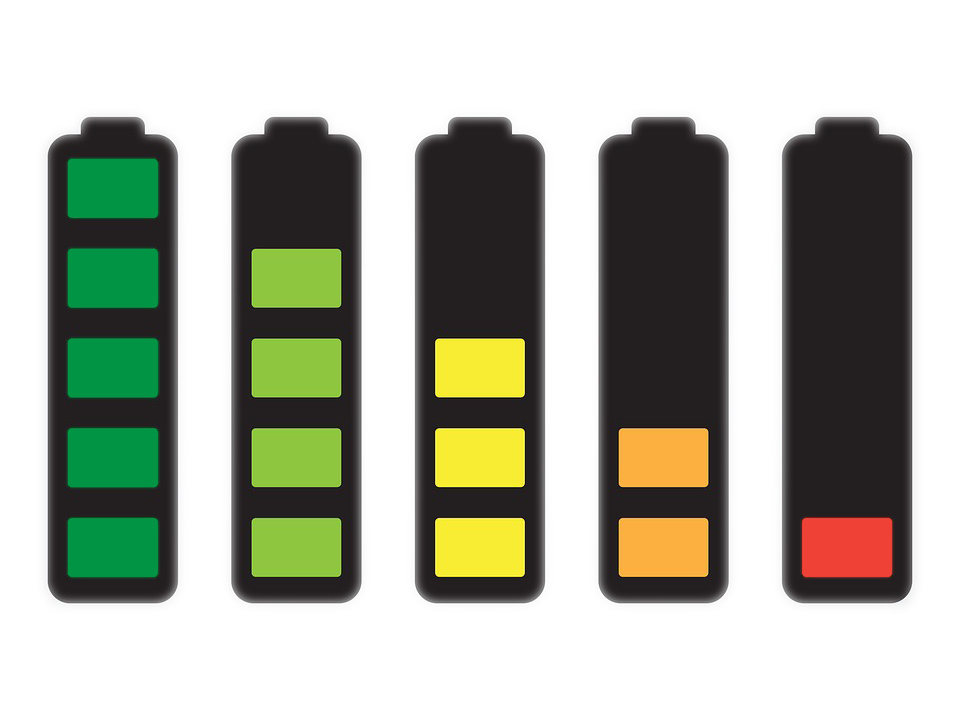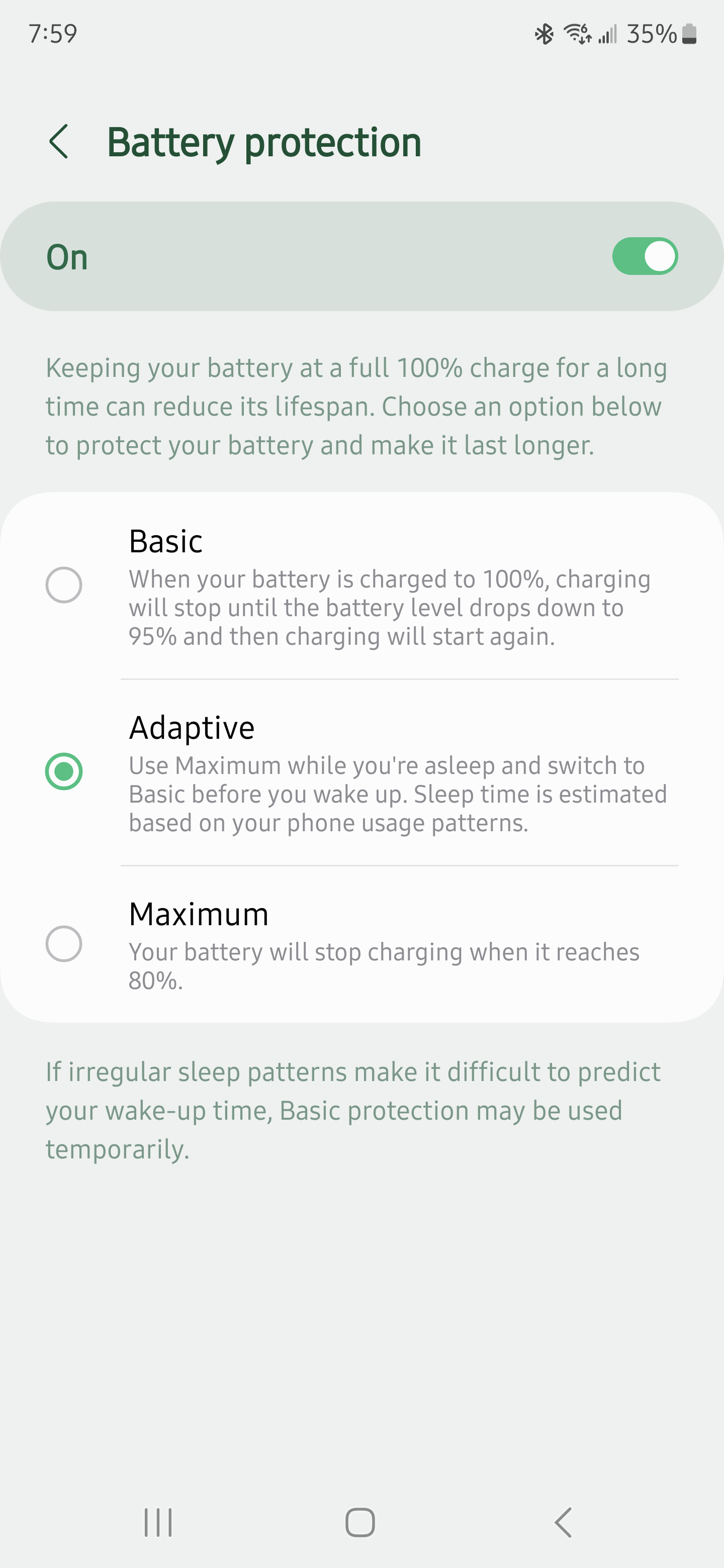Yeah give your phone a 20% battery handicap out of the box because of your battery degredation paranoia. Dumbest shit ever.
Why wait 10 years to get a 20% battery degradation when you can have it today!?
It’s not paranoia, it’s an issue of how Li-ion batteries work.
Literally. It even extends to other Lithium based chemistries too, like LiFePo4.
It’s not like this information is hiding either - ask a battery manufacturer/distributor for a Li-ion cell’s charge cycle data, what you’ll find is most manufacturers only guarantee 300-500 cycles before the battery has lost 80% of its usable capacity at 100% DoD and charging to the 100% SoC voltage. Decreasing just the maximum SoC to 90% brings massive battery longevity gains, where estimated cycles increase to 1000 (and beyond in some cases), while still retaining over 80% of the battery’s usable capacity.
All my personal devices that I’ve checked sadly target 100% SoC voltage and charge rate, without regard for the longevity of the battery. Just seems almost like they’ve just punched in the numbers from the “ABSOLUTE MAX RATINGS” part of the datasheet and called it a day.
It’s a little disappointing that a lot of people are under the belief that their product has been designed to last as long as it can, when in most cases this intentionally or accidentally isn’t the case right now, in industries outside of backup power and EVs
I just charge my phone to full when it’s at like 20 and then unplug it when it’s done charging. Have had this phone for like 2 and a half years and I don’t have noticeable degradation, but it’s a flagship samsung phone so I know they typically have pretty good cells in them.
I very rarely need a full charge when I get a new phone. Battery rarely drops under 50% unless it’s a heavy use day. However, that same phone 3 years later will be causing me issues because the battery doesn’t last through the day.
I would happily trade off 20% max battery in the first few years, to get a healthier battery 4 years down the line.
I hear the same argument about EVs, where many charge to 80%. Sometimes you need that extra juice, and by all means use it. Other times you’re only going to the grocery store, or sitting at your desk all day, and you can stay plugged in and you don’t really need that 20%. It’s no real skin off your nose either way.
Then, years from now when you need as much energy as your battery can give, you haven’t lost it to degradation and you really haven’t lost much along the way.
Depends who you ask. To manufacturers it’s a brilliant idea. It’s not a mystery that no electrical engineer knows that Li-Ion batteries don’t like to be fully charged. It’s just that manufacturers realized that charging 100% means you battery will die at around 2 year mark or 600-1000 charge cycles and that will be enough push for some people to buy a new device while at the same time your device seems to last longer on a single charge. Charging to 80% or 85% significantly extends life span of a battery. At that point chemistry almost doesn’t degrade.
And it’s not just with mobile devices and batteries that this is happening. Engineering with a plan to fail at specific time has become a precise science. Making something that will last forever is not that difficult, just not lucrative to them. Take for example LED lights. Manufacturer states 50k hours at 3.1V for white LED. Reduce that voltage down to 2.5V and you have basically made it infinite but it glows less, so to compensate you’d have to add more LEDs and that hits their income. Big Clive has a great video on the subject.
I don’t know, I have a bunch of years old Sony Konion vtc5 and vtc6 18650s, they’re constantly loaded and drained, I guess some have thousands of cycles. Of course, they’re not new anymore, but even my oldest ones, 7 years plus, are ok. They still give 34 ampere for quite some time, so no problems here. Got some even older no-name ones in akku packs, 10 years old, not so many cycles, no problems there either. Maybe because I never charged them quickly and with adaptive voltage?!?
There are 18650 batteries with protection circuit and without. It’s basically over-charge, under-charge and high temperature protection. More info. When charging any battery higher voltage means faster charge and it’s usually not a problem. What is a problem is heat generated. If you can’t dissipate heat fast enough, then you have a potential problem. Slower charging is always safer.
And all charging processes are adaptive voltage to a degree. Say you are charging 18650. Your charger will start with target voltage and constant current at 500mA, and watch the voltage in the battery raise. Once voltage reaches target it will remain constant but charge current will slowly drop. Once there’s no current going in, battery is full at that voltage level. Some chargers will push more current in, some will try higher voltage initially then switch to target voltage. Higher current can be a problem due to chemistry stability and heat but higher voltage should generally be safe. You can even revive some of the old batteries that no longer have any charge by shocking them with higher voltage shortly.
Also, good charger matters a lot.
This should not only result in government regulation where artificial battery killing is prohibited, it should result it jailing execs who decided this was a good idea.
Here is an alternative Piped link(s):
Piped is a privacy-respecting open-source alternative frontend to YouTube.
I’m open-source; check me out at GitHub.
For android users, we can easily set notifications if battery level reach certain range by using apps like Tasker. Before this I set it for full charge. Change it to above 80% just now.
EDIT: tasker proj file in case anyone is interested. Link.
Samsung straight up has battery protection option which doesn’t allow it to charge above 85%.
Nice. But I don’t use Samsung. Used to but no more.
Am assuming it will drip to other manufacturers pretty fast. I think Motorola already has it.
I thought it was available in every brand already.
It exists in OnePlus, Oppo and Assus.
I wouldn’t be surprised. Hardware should already be there since Android supports stopping charge when battery is too hot. Adding software feature to stop charge at certain percentage is not that difficult.
Built-in Meta services?
Thank you for the great tip. I have turned this on.
You are welcome.
There used to be a magisk module that would charge the battery intelligently and stop before b Full charge but I don’t think it exists anymore sadly, or at least I haven’t been able to find it
I see that features in phones that I’ve used within the past 5 years. Isn’t it a standard feature?
No I’m pretty sure it’s not, I’ve used about 5 different phones on the last 5 years and one iPhone and I’ve never seen it on by default
But is the option available on every phone?
No I’m also pretty sure it’s not, thats something I would have checked for on each. I’m pretty sure this is just a Samsung thing
I have this option in my 1plus, Oppo, Assus. So, I thought that they are standard already. Good to know.
On Samsung phones it’s just an option in the settings.
Yup. Called “protect battery”.
That is ACC, still alive and kicking. Here is a gui front end for it, you can get it from fdroid or GitHub https://github.com/MatteCarra/AccA
Degraded battery life is rarely the thing that tanks a device for me (sure, it degrades, but it’s rarely the reason I replace it). I mean it’s great to know about this, but the last four phones I’ve replaced have been because (a) my old phone didn’t work on my new network, (b) my camera failed, © my chipset wasn’t up to the task of the most recent OS update, and (d) there was a fundamental flaw in my handset and the manufacturer offered a $50 upgrade to their newer model with trade.
Actually, thinking about it, a and b might be switched, but the point stands: it’s probably been twenty years since battery life was the reason I upgraded (from a flip phone to another flip phone, iirc).
… Aren’t devices designed to only charge the battery to 90% (and report that as 100%), because actually changing a battery to 100% is pretty harmful for it?
You’re thinking of cars, industry and others that have high value batteries.
Power tools, smartphones etc charge to the maximum 4.2V/cell, sometimes even 4.3V (some chemistries safely allow it) because the average person just wants the maximum runtime and will replace the equipment before the battery degrades significantly.
Yeah, I’m pretty sure I read that somewhere too. The reason being overcharging just once basically kills them, so they give it a lot of leeway and say it’s 100% well before that.
This sounds like the battery and the charger’s problem to handle, not mine.
All this tech, all this automation for every damn thing, and people keep coming at me like I’m supposed to do everything manually with my fingers and eyes and maybe an alarm or something to keep me on schedule. No. Stop it.
Make the charger handle it, or shut up. Make the phone, the charger, and the battery handle it together, you know, with digital automation. Do not even mention it to me.
deleted by creator
He’s directing it to a forum of people under a topic regarding phones not being optimized to charge past 80%. Quite a fair frustration I’d say, since most people charge their phones while sleeping. The technology should stop charging automatically
I charge mine at night with an alarm on it for getting up in the morning, my dad however charges his multiple times a day as he puts it on when it only drops down to 95-80%.
deleted by creator
Except many like mine don’t have that option. The best they have is “optimized” charging that tries to only hit full when you go to unplug it.
Sir, this is a lemmy. It’s all about figuring out how to be the most outraged rather than the most rational.
Nah, that’s Reddit.
It’s funny how people think that the users here are substantially different than reddit users. It’s the same shit, just fewer of us and the political alignment is further left.
Let’s not bring that energy. Let’s try to be better.
Just kidding! Or am I?
I doubt this is directed at ifixit. I agree with their general comment, but at the same time device manufacturers have no incentive to make their devices last longer unless they are forced to.
Samsung phones have the capability to do this. There’s a setting you can set to only charge to 80%. It looks like they mention that in the article.
Android phones in general have something called Adaptive Charging that attunes to when you normally need a full charge. For instance if you are charging at night while you’re sleeping it will charge slower than it would during the day to improve battery health.
Mine automatically charges to 80% if you have an alarm set, then it charges the rest in the last minutes.
100% agree. Mate, there’s an another ongoing post on lemmy about autosaving documents, and how everyone seems to think that saving files with their fingers pressing keys on a keyboard is the best approach possible in 2024 because software just can’t do this reliably.
Of course everyone also knows better than their charger, battery and device.
Yup. If it’s such a huge issue, phones should only charge to 80% and report that to the user as 100%. But phone manufacturers won’t do that, because users want to be able to report the longest battery life possible when selling new phones. They don’t care that the charging habits are bad for battery longevity, because the user has already purchased the phone.
And they will purchase their next phone sooner if the battery on their old phones die early.
Your device manufacturer has designed it to break in as many ways as possible so you have to buy a new one.
Why do you think everyone switched to non-removable batteries?
If you don’t take responsibility for your device, you are just like the people that think not owning your own hardware is fine.
Why do you think everyone switched to non-removable batteries?
Well the purported reasoning is that less shielding is required. Seems plausible but IDK how true. I assume it’s partly true.
Some day you will learn that nearly every justification made by corporations like this is bullshit.
But I bet they’re glad you continue to spread it so loyally.
you continue to spread it so loyally
Whatever mate.
My comment acknowledges that it’s a dubious claim. I’d hardly call that spreading nonsense loyally.
Let the corps fuck you for a few more decades and you’ll be jaded like me.
More probably because the fucking bloodsuckers are getting better at it.
Jaded?
No, I think you’re just another snarky Lemmy commenter that doesn’t bother actually readying and understanding anything but trots out the same tired positions in thread after thread.
You really don’t have to be like this. You choose to be this way.
deleted by creator
No, it’s your problem.
The manufacturers correctly surmise that most people prefer a battery that holds it’s charge longer over the first year or so, rather than a battery that will last more years.
If your preferences differ from that of most people, then you need to exercise your preferences.
When you say “make it do x and y” who should be the person that does it? Without raising enough awareness of the problem, change will not happen. The only way for it to happen is that enough people is pissed off and changes brands.
Damn, some of you must have pretty chill lives if paying attention to what level your battery charge is at DAILY is something you want to add to your plates. I mean sure, if there was a setting that allowed you to have the phone automatically cut charging at 80% this might be worth thinking about. But when I charge my phone its during times when I dont have to think about it (Aka 90% of the time, when I’m asleep)
I’ve stopped charging my phone overnight which I typically advise people against but also keep a charger at my desk. My phone actually has a battery saver setting that cuts charging at 85%.
Overnight is literally the easiest and most natural slot to do so. Whether or not its most optimal is not whats important, I’ll just seek out brands that aknowledge this reality and build their hardware and software around this
What kind of phone do you have. Samsing, Apple and Pixel all have solutions.
The used prixel I got recently automatically only charges to 80% if an alarm is set, then charges the rest of the way to hit 100% when the alarm goes off.
My pixel (5a) only does adaptive charging if your alarm is set for the A.M. If you’re second or third shift, it doesn’t even try. There’s no way to turn it on even in developer options. It was a pretty big wtf when I figured that one out.
Its more I’m lazy. I’m on a ROG Phone 3, and as a gaming phone it probably has that feature. I’m moreso just arguing that if this is still an issue batteries face, tech should address it and fin solutions for how to get around the most common form of charging which is plugging it in and doing something else, which inherently means you ARENT watching what charge its at and have little control over when it stops charging
True, of course the simplest and easiest solution is the one that takes the least amount of thinking and effort.
My only issue is there are brands that try to build around this but it’s incredibly difficult. I understand iPhones have some kind of smart charging that’s supposed to charge slowly but stop until it learns when it thinks you’ll need it and finish charging just before then. However, that relies on consistent data and consistent routine and I would think that could potentially be quite inaccurate if you have a more inconsistent routine. I don’t think I’ve seen a better implementation yet unfortunately.
It’s just become second nature to me to watch for and charge my phone so certain times. I feel like that’s just a part of owning a mobile device.
Yeah, thats kind of my point. Plugging your phone in every night when you go to bed is a pretty natural and low thought way of charging any electronic device
Samsung has this option, called Battery Protect I think. There’s also the Accubattery app which will set an alarm to go off once it reaches 80 pct. I’m with you though, unless the phone itself shuts off charging, it’s too much to manage even with an alarm.
S23 Ultra: Protect Battery - 85 percent toggle
I tried it before but my anxiety was always going . Thinking to try again.
My phone has exactly this (oneplus 9 pro) but it works only when there is a full moon and the next Friday is the thirteen’s day of the month, plus some other unknown requirements
I’ve a one plus Nord 2 5g and it has optimised charging at night but it doesn’t come on every night I charge it and it does feel like there’s some arcane shit needed for it to work at times.
deleted by creator
My samsung n20 ultra has the 85% charge option built in and I’ve always used it to keep my battery good. Back when it was easier to use custom roms in the 2010-2014 Era there was a lost of them that had custom “stop charging options” like it.
I also have fast/ultra fast charging disabled. If you don’t need to quickly charge your phone, it’s something else you should avoid.
For steam deck owners it gets a bit more complicated. SD has pass through charging, so once the battery is fully charged and also while it is plugged in, you aren’t powering it through the battery like cell phones and most laptops do. It’s just running off the USB c power, so if you usually play while plugged in, you aren’t cycling the battery, but you are having to allow it to fully charge.
SD has pass through charging, so once the battery is fully charged and also while it is plugged in, you aren’t powering it through the battery like cell phones and most laptops do.
That’s how nearly all modern devices work. Li-Ion can’t be charged and discharged simultaneously. There is circuitry to split the power between the battery and the device when it’s being charged.
Cheaper devices will just stop charging when you use them or they won’t work at all when plugged in.
This is flat out not true for most phones. Most phones will charge to 100% and continously charge/discharge if still plugged in. Over the last couple years there’s been some phones that will allow pass through/bypass charging. Iphones don’t do it at all. Only some android phones.
If it shouldn’t be charged above 80%, then make 80% the new 100%. “But this one goes to 11”
They already did. The percentage range on your phone’s battery display is basically a usable range rather than an absolute range. The article talks about phone manufacturers making changes to their charging systems to optimize battery function, but the headline bit about not charging past a certain point has been taken into account by Android and iOS for ages.
Very few android phones actually have this feature, most manufacturers strip it
A lot of charging circuits and battery designs already do this transparently.
Yes. Batteries are bags of chemicals. They don’t really have percentages. Where you decide 100% is is somewhat arbitrary and up to the battery management.
What the system shows the user may be even a completely different number and there may be software adjustable values.
It’s inherently a made up number and a manufacturer can decide to be more brutal or more sparing in how they treat the chemicals.
Just build phones with the understanding that batteries are consumables and make them easy to replace and standardized. Then swap in a new $5 battery when you need to so. Make the raw materials reclaimable too of course.
Do most people not have the option to protect their battery already?
“Sleep time is estimated based on your usage patterns”
These systems exist on pretty much all modern phones, but they all work the same (shitty) way, by assuming your schedule is exactly the same every day and giving you zero programmable control.
And on iPhone the system expects you want your battery to charge over 80% on a daily basis. On a Samsung phone the system knows you don’t want to go past 80% at all, so it sets that as the new maximum.
I think that’s a Samsung feature
It’s built into my pixel as well. Shrug
You have an older Pixel or just rooted, maybe? My 7 on the latest vanilla Android doesn’t seem to have it, and this thread seems to say it’s not available in the stock os.
Is called adaptive charging
It’s on my pixel 7 pro at least
Ah, I see. I was focused on the 80% limiter for that “Maximum” setting, which I think is not an option on Pixel. But I see now that “Adaptive Charging” sounds like it does what that middle setting “Adaptive” does.
But then you aren’t forced to buy a new phone every few years?
No one is forced. Especially with fast charging.
Sure, if my battery lasts literally 30min, I’m totally not forced to buy a new phone. I’ll just fast charge my way through the world.
30 min? LMAO.
I literally know someone with this type of issue. Battery goes from like 70 to 20 in maybe 20 minutes
Their phone isn’t even that old
I know lemmy hates Apple but HOW?!
My five year old iPhone lasts all day, and is as fast as what I bought it?!
That battery has to be bad. I loved the shit out of my HTC Dream but that only went from 30% to 0 when the battery was BUSTIN
deleted by creator
not entirely sure tbh Just know their battery is shit at this point
It was probably abused. I’ve never had a phone get that bad and I really do not think that is some widespread thing. Otherwise you’d see a lot of three year old EVs with a 20 mile range.
Toward the end of my pixel 5’s life, the battery in it lasted about 10 minutes. The phone itself was 3 years old. It happens.
How?! I’m currently on a five year old phone that lasts all day with its original battery?!
I get the feeling it has to do with how wireless charging works. On a wire, a phone can regulate how quickly it takes charge or whether it does at all. I don’t think phones are capable of that with wireless charging, which is exclusively how I charged my pixel 5 at night.
So it would get to 100% and stay there for several hours every single night. I didn’t realize it was bad at the time.
It could always just be that I was unlucky and got a defective battery to begin with. No way to know for sure.
Abuse or defects or environment. I’ve, for example, seen one phone which was constantly woken up (technical term in case it sounds odd) because of some event in the wireless signal and that made it use up the battery in a ridiculously short time. It was a combination of the way a network was set up, bad signal quality, and a firmware quirk. Clearly a defect, but hard to say whose. Forcing it to use some mode in the radio via settings circumvented that.
What? No just a new battery. That’s the point.
That’s the point of what this guy is saying.
But the point of making batteries not easily removable (besides the waterproofing factor) is that when a repair shop charges them $150 to do it, lots of people will justify putting that money towards a new phone instead.
As someone who works on phones as a hobby, I’ve seen that the percentage of people who will either hire someone to do it or buy a different phone is near 100. It’s absolutely an intentional planned obsolescence.
Waterproofing is a lame excuse that I won’t accept from these manufacturers. It may be not as easy as just permanently gluing the thing together, but it’s definitely possible to have a sealed battery compartment.
For example cameras have been weatherproof for decades now. And you can both change the batteries and plug a bunch of stuff in them no problem.
They were being sarcastic and quoting something a phone manufacturer would say.
The money is in the software services nowadays anyway. Subscription AI bullshit, cloud n stuff.
To be clear, you are still taking about rechargeable batteries right? I agree those should be replaceable. I sure as hell don’t think phone should use single use batteries!
Yes, 18650 or a standardized rectangular equivalent.
A standard would be nice… I mean all phones are basically the same size and shape.
This is what the new European bill is forcing manufacturers to do.
Batteries of handheld electronics have to be easily replaceable.
No. People online have really misrepresented that bill.
All it says is that it should be easily replaceable by someone of moderate skill. I.e. still having to pry open your phone carefully, but now without using strong adhesive.
It also doesn’t apply for phone batteries over a certain size, or batteries that will still retain a set amount of capacity after a few years (I think 73%).
People are heavily, heavily mistaken if they think it’ll be a return to the days of trivially removable batteries.
The biggest barrier for “most people with moderate skill” is having to acquire equipment to replace the battery. Once it becomes too much effort and cost it’s better for most consumers to take it to the manufacturer or 3rd party service for replacement.
I stopped replacing batteries once I needed to heat the adhesive to remove the back and screen as I don’t have that equipment to hand, and initial attempts caused damage to the screen and back cover.
It’s a start but pretty weak.
Weak in which sense ?
Looking forward to the first lawsuit about this.
Sure, but let’s also preserve current batteries as long as possible so we can lower our carbon foot print. We need to do both.
Here’s my headline: Why obsessing over battery degradation is unhealthy and you should just do whatever is easiest for you
“hey here is a way to increase the life of your battery by possibly 400%.”
“OMG! Why are you obsessing over this!”
Seriously how dare they try to help us and educate us!
the 400% figure is extremely misleading and based on old assumptions and old battery tech.
Also it you’re not keeping the phone for 20 years then it doesn’t make sense to calculate “total electrons” over the absolute entirety of the battery “life”.
Agreed. If you’re a device maker and you haven’t considered the possibility of your users plugging in their devices for long periods of time in your design, then i feel that’s on you to improve your product.
I have enabled the option to limit charging to 85% on my Samsung, and last weekend I needed it to last for 2 days so I charged it to 100%. Easily made it. It’s nice to know you have that 100% when you need it .
They talk about Apple but Sony phones have had this feature for a while. In the settings you can choose whether the phone is always 100% charged, or whether it charges to 80% (or a custom %) or whether you want it full by the time you wake up.
I use the 3rd option. It stops charging when it gets to 90% and I tell it when I’m getting up, and just before it will charge up to 100 %.
Best of both worlds. Only ever having 80% to start is not nice because you get less juice during the day and need to charge by the evening. Plus battery anxiety. I’d rather have a 100% full battery.
Clearly newer, better battery tech is needed. Plus replaceable batteries.
Samsung, too.
I use it because I want my phone to last as long as possible, but the downside is that it won’t last a day so I have to charge in between. Ironic, isn’t it?
Very ironic.
That’s why I just tell it to be full by morning because I purposely bought a phone with a great battery . Why would I want to hamper it by 20%???
I know plenty of devices will stop charging when the battery is optimal and just say it’s at 100% even though it’s 80.
Samsung has a setting for 85%, i know my phone only charging to 85% does not get as hot.
If 80% is enough, there is not much to loose that is usually where the battery health finds its plateau after some years. I rather change my battery once it hits 80% health after two years. I don’t want to use it like it would behave when the battery is already dead.
























